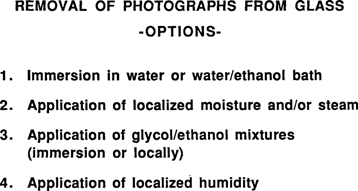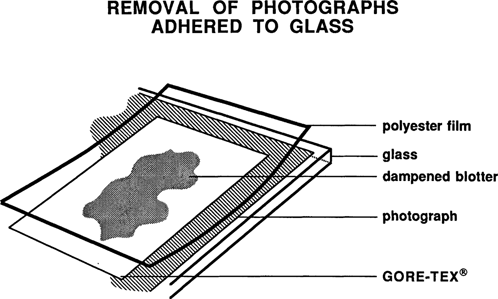
Topics in Photographic Preservation 1989, Volume 3, Article 12 (pp. 86-91)
This paper will address the conservation treatment of a framed panoramic silver gelatin photograph which was received in a very fragile condition. The owner wished that it be stabilized but did not desire extensive and complex cosmetic treatment.
The photograph was firmly adhered to its glass at all outer edges. In many instances the gelatin binder had cracked and torn along the adhered and non adhered interfaces. The photograph's paper support was generally yellowed, severely water damaged, and irreversibly stained along the lower edge. Evidence of mold damage was visible in these areas and in many instances the gelatin binder layer was actively flaking or lost entirely. The photograph's filamentary silver image was somewhat discolored and slightly mirrored in the dense image areas. The photograph exhibited severe planar distortion and abundant surface dirt and embedded grime throughout. An ink inscription at the center bottom was suspected to be water sensitive.
A proposal for treatment emphasizing stabilization and long term preservation (with some consideration given to cosmetic improvements) included; surface cleaning the reverse to reduce dirt and embedded grime with erasers, removal of the photograph from glass, (if possible), consolidation of the areas of actively flaking gelatin binder, reattachment of detached fragments adhered to the glass, surface cleaning of the obverse as much as safely possible, general stain reduction, structural repair to the paper support and overall design compensation through minimal inpainting, and flattening of the cockled primary support.
Options for removal of the photograph from glass were surveyed, some of which are listed in Figure 1. In this instance the fragility of the gelatin binder layer and sensitivity of the ink inscription to moisture, as well as the severe discoloration of the photograph's paper support and its strong proclivity towards staining precluded the use of direct moisture, hot steam, or water/alcohol solutions. Furthermore, owing to its size it was determined that a localized treatment would afford much greater control.

Figure 1
The use of hexylene glycol (specifically Pakasol, a print conditioner, manufactured by the Pako Corporation, and recommended for glossing and flattening prints) mixed with alcohol and/or water as reported by Chris Young and Siegfried Remple at AIC/PMG 1984 Winter Meeting in Louisville was considered. These long-chained glycols, which may be applied locally, physically interact to plasticize the gelatin binder, increasing its flexibility and thereby allowing for mechanical detachment from the glass. In the case of this heavily stained photograph, however, it was determined that solutions (even those containing high percentages of ethanol) could not be-applied to the reverse of the photograph without inducing disfiguring and irreversible staining.
A method for utilizing moisture vapor but not liquid water for removal of this photograph from glass was investigated. A Gore-tex membrane laminated with 100% non-woven polyester (available from W. L. Gore & Associates, Inc.) was chosen to aid in this process. Gore-tex is an aerated teflon—liquid water does not penetrate the Gore-tex barrier because of its high surface tension as well as the low absorption and small pore size of the Gore-tex membrane. The matrix pores of the Gore-tex membrane allows for the passage of water vapor.
To facilitate removal of the photograph from the glass, the following steps were undertaken:

Figure 2
Once the photograph was entirely removed from the glass the photograph was closely examined for condition. Areas of actively flaking gelatin binder were locally consolidated with a 2% gelatin solution. The photograph was surface cleaned on the obverse with distilled water and water/ethanol mixtures to minimize swelling of the gelatin binder.
Attempts were made to minimize water staining along the lower edge of the photograph by local application of moisture. These areas were so badly degraded that in most instances moisture could not be safely used. A viscous, acetone/water gel applied directly to the surface of the photograph acted to minimize staining in some areas. (1) Although not highly successful in this particular treatment, this, and other solvent gels, (invented and introduced to the field of conservation by Richard Wolbers, Professor, University of Delaware/ Winterthur Museum Art Conservation Program) may prove very useful to photograph conservators in the future.
Following stain reduction, fragments of the photograph adhered to the reverse of the glass were transferred. To do this, the fragments were saturated with water (to which a small amount of ethanol had been added to improve penetration) and manipulated away from the glass with a sable brush. Fragments were flattened and readhered to the photograph in their original location with a dilute wheat starch paste or methyl cellulose adhesive.
Structural damage in the photograph's paper support were mended on the reverse with a Kozo-fibered Japanese paper and wheat starch paste.
Losses in the gelatin binder layer were locally sized with a dilute gelatin solution and inpainted in selective image areas with watercolors and Magna Bocour (n-butyl methacrylate) colors in xylene. Magna Bocour colors may be applied in thin transparent coats, like watercolors or more opaquely, if desired. They are applied without water and therefore do not bead-up upon glossy surfaces as watercolors often do. Diluted acrylic resins, such as Acryloid B-67, available commercially in matte or glossy finishes, may be mixed in with the Magna to create the desired surface character.
Once inpainted the photograph was gently humidified and flattened between polyester web and blotters, and under glass and weights. In an attempt to minimize curling, the photograph was humidified by placing damp blotters on the paper support side only. The inclusion of polyester film on the reverse (non-binder side) of this humidified photograph during flattening helped to minimize its tendency to curl upon drying.
The treatment described above allowed this photograph to be successfully removed from the glass to which it was firmly adhered. Although still severely and irreversibly disfigured, the photograph may now be safely handled and protectively housed as necessary. (It must be noted that this treatment technique does not solve the visual problem of what often proves to be an irreversible surface modification, or ferrotyping, of the gelatin binder. In some, but not all, cases this ferrotyping may be reduced by immersion in a distilled water bath. Surface coating may also be considered but reversibility and adhesion must be carefully considered.)
A Gore-tex/non-woven polyester laminate was utilized for removal of other photographs adhered to glass and has proven to be successful in most instances. It appears to be ideal for those situations where photographs may not be safely immersed or treated with liquid water or water/ethanol solutions owing to the presence of dangerously deteriorated binder layers or water-soluble coloring or inscriptions.
Conservators will continue to be faced with photographs adhered to glass. This treatment has been presented as a suggested possibility to add to our ever increasing repertoire of conservation treatment procedures.
Thanks to all of my colleagues who generously offered advise on techniques and materials for the removal of photographs adhered to glass. Special mention and thanks to Connie McCabe who helped with the conservation treatment of this panoramic photograph and the development of the treatment technique for its removal from glass.